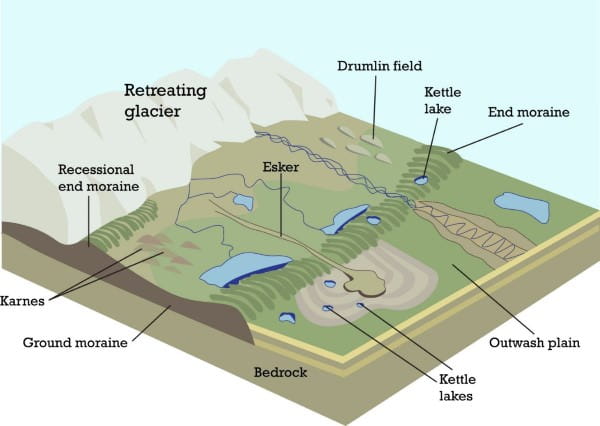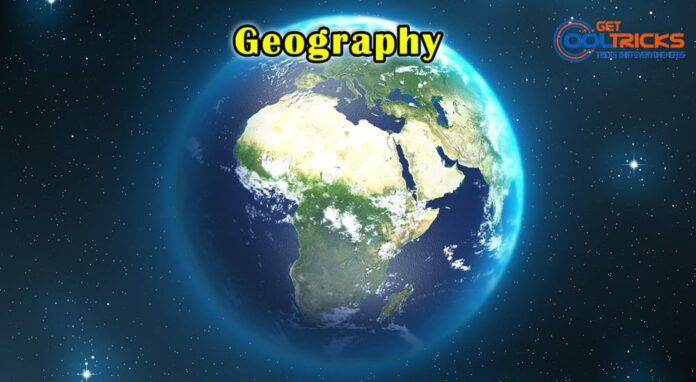About Glacier
- Glaciers are a mass of ice moving under its own weight. They are commonly found in the snow-fields.
- We know that the landmass on the earth is not entirely the same as we see around.
- Some areas are covered by thick green forests, some with dry hot deserts, some with permanent ice covers etc. Among these varied landmasses, the permanently ice-covered regions on the earth surface are called as snow-fields.
- The lowest limit of permanent snow or snow-field is called as the snowline.
- A Glacier forms in areas where the accumulation of snow exceeds its ablation (melting and sublimation) over many years, often centuries.
- They form features like crevasses, seracs etc. A crevasse is a deep crack, or fracture, found in an ice sheet or glacier, as opposed to a crevice that forms in rock. A serac is a block or column of glacial ice, often formed by intersecting crevasses on a glacier.
- Ogives are alternating wave crests and valleys (troughs) that appear as dark and light bands of ice on glacier surfaces. They are linked to the seasonal motion of glaciers; the width of one dark and one light band generally equals the annual movement of the glacier.
- Glaciers cover about 10 percent of Earth’s land surface and they are the largest freshwater reservoirs on earth.
On the basis of the location of the glacier, they can be classified as:
- Continental Glacier/Piedmont Glacier: they move outward in all directions
- Valley/Mountain Glaciers: Move from higher elevation to lower

Erosional landforms due to Glaciers
1. Cirque or Corris
- They are deep, long and wide troughs or basins with very steep concave to vertically dropping high walls at their head as well as sides.
- They are simply bowl-shaped depressions formed due to the erosional activity of glaciers.
- When these depressions are filled with water, they are called Cirque lake or Corrie Lake or Tarn Lakes.
2. Hanging Valleys or U-shaped Valleys, Fjords/fiords
- The Glacier doesn’t create a new valley like a river does but deepens and widens a pre-existing valley by smoothening away the irregularities.
- These valleys, which are formed by the glacial erosions assume the shape of the letter ‘U’ and hence are called as U-shaped Valleys or Hanging Valleys.
- A fjord is a very deep glacial trough filled with seawater and made up of shorelines.
- A fjord is formed when a glacier cuts a U-shaped valley by ice segregation and abrasion of the surrounding bedrock and this valley gradually gets filled with seawater (formed in mountains nearby the sea).
3. Horns and Aretes
- Horns are sharp pointed and steep-sided peaks.
- They are formed by headward erosion of cirque wall.
- When the divide between two cirque walls gets narrow because of progressive erosions, it results in the formation of a saw-toothed ridge called Arete.
Depositional Landforms due to Glaciers
Glacial deposits are of two types:
- (i) Glacial Till – unassorted coarse and fine debris;
- (ii) Outwash – assorted roughly stratified deposits.
1. Moraines
- Moraines are long ridges of deposits of glacial till.
- When these deposits are at the end of a glacier, they are called Terminal moraines and when they are deposited on both sides, they are called Lateral moraines.
- When lateral moraines of two glaciers join together, they form Medial moraines.
- When the lateral moraines of both sides of a glacier join together, it forms a horseshoe shape.
- Ground moraines are deposits left behind in areas once covered by glaciers.
2. Eskers
- When glaciers melt in summer, the water which formed as a result of melting accumulates beneath the glacier and flows like streams in channels beneath that ice.
- Very coarse material like boulders, blocks and some minor fractions of rock debris are carried away by these streams.
- They later get deposited in the valleys itself and once the ice melts completely, they are visible to the surface as sinuous ridges.
- These ridges are called as Eskers.
3. Drumlins
- They are smooth oval-shaped ridge-like structures composed mainly of glacial till.
- It shapes like an inverted spoon with the highest part called as Stoss End and the lowest narrow part called as Tail End.
- They are formed as a result of glacial movement over some minor obstructions like small surface rocks.
- The glacial till gets deposited in those obstructions and the movement of the glacier shapes these deposits like an inverted spoon.
Outwash Plain
- When the glacier reaches its lowest point and melts, it leaves behind a stratified deposition material, consisting of rock debris, clay, sand, gravel etc. This layered surface is called a till plain or an outwash plain.
Kame Terraces
- Broken ridges or un-assorted depositions look like a hump in a till plain.
Kettle Holes
- Formed when the deposited material in a till plain gets depressed locally and forms a basin.
Glacial Cycle of Erosion
Youth
- The stage is marked by the inward-cutting activity of ice in a cirque.
- Aretes and horns are emerging. The hanging valleys are not prominent at this stage.
Maturity
- Hanging valleys start emerging. The opposite cirques come closer and the glacial trough acquires a stepped profile which is regular and graded.
Old Age
- The emergence of a ‘U’-shaped valley marks the beginning of old age.
- An outwash plain with features such as eskers, kame terraces, drumlins, kettle holes etc. is a prominent development.


